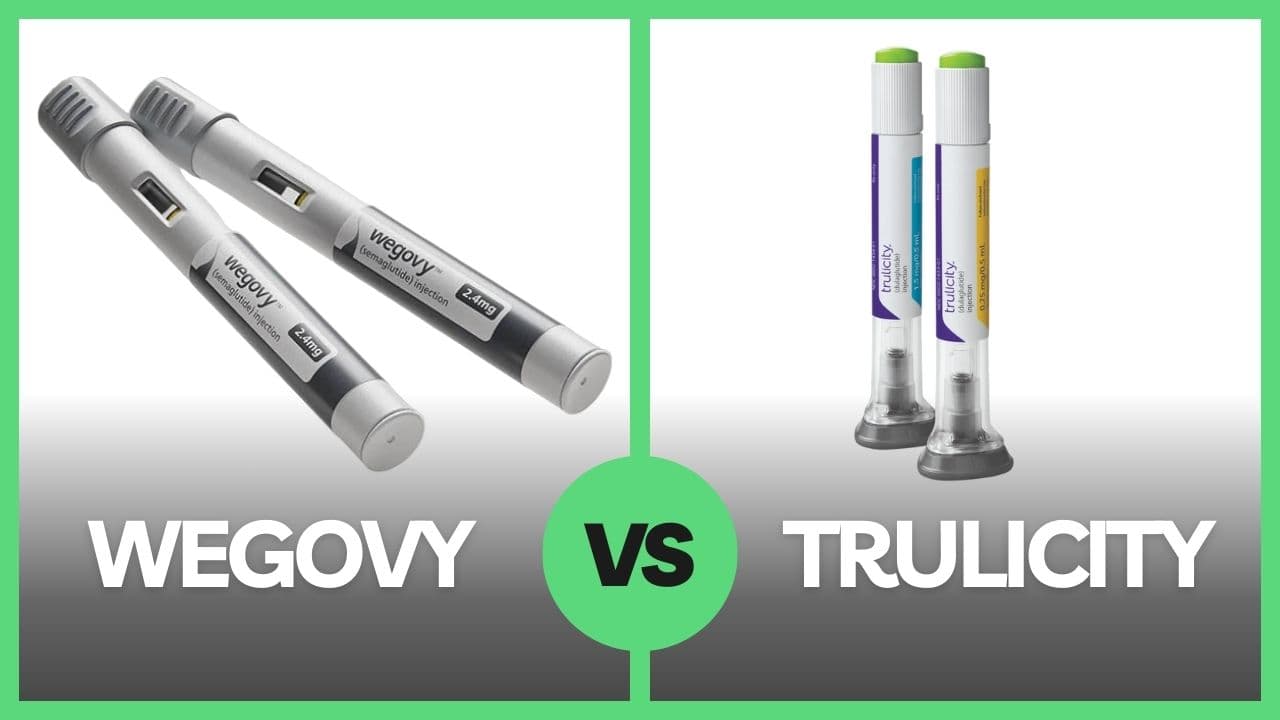Both Wegovy and Trulicity have been prescribed for weight loss. They each belong to the same class of drugs known as glucagon-like peptide-1 (GLP-1) agonists but do not have the same active ingredient. The active ingredient in Wegovy is semaglutide, in Trulicity it is dulaglutide.
Drugs such as semaglutide and dulaglutide work by mimicking the effects of the hormone GLP-1 in the body. GLP-1 is associated with how long food remains in your stomach and your feelings of hunger or satiety.
The drugs have similar actions, and they are both taken as weekly injectables, only Wegovy has been clinically studied specifically for weight management and has been FDA-approved as a weight loss drug. Trulicity, on the other hand, is approved and normally prescribed for the control of type 2 diabetes, and in such users, it has also been shown to stimulate weight loss.
Let’s take a closer look at the other differences between the two drugs and see which is more effective for weight loss.
Main Differences Between Trulicity Wegovy
Wegovy is made by Novo Nordisk, and Trulicity is made by Eli Lilly.
Here are some more details of Trulicity vs. Wegovy.
Mechanism of Action
Wegovy belongs to a class of drugs called GLP-1 receptor agonists. Such drugs mimic the action of a hormone called glucagon-like peptide-1 (GLP-1). GLP-1 is naturally released after meals and helps regulate appetite. By activating GLP-1 receptors, Wegovy reduces feelings of hunger and promotes a sense of fullness, which can lead to reduced food intake.
Trulicity also belongs to the GLP-1 receptor agonist class and employs dulaglutide to achieve its effects. Similar to Wegovy, Trulicity activates GLP-1 receptors to enhance satiety, delay gastric emptying, and promote insulin secretion in response to meals.
Target Audience
Wegovy is primarily indicated for individuals who meet specific criteria related to their Body Mass Index (BMI). It is typically recommended for those with a BMI of 27 or higher, provided they have at least one weight-related condition.
Alternatively, it is suitable for individuals with a BMI of 30 or higher. Wegovy has also received approval for the management of weight in adolescents aged 12 and older who possess a BMI at or above the 95th percentile relative to their age and sex.
Trulicity is indicated for individuals with type 2 diabetes to manage blood sugar levels. While its primary purpose is glycemic control, its appetite-suppressing effects can also lead to weight loss, making it suitable for overweight or obese individuals with diabetes.
Effectiveness for Weight Loss
Wegovy has been tested in patients with and without diabetes. During FDA evaluation, adults achieved remarkable weight loss results of up to 15% of their overall body weight. In a distinct study focused on adolescents, the average weight loss reached an impressive 16% of their initial body weight.
Trulicity is not specifically prescribed for weight loss, nor has it ever been studied strictly as a weight loss drug; however, while Trulicity’s primary focus is on glycemic control for individuals with type 2 diabetes, it has also exhibited modest weight loss effects.
Clinical trials have reported weight reductions of around 2-6% of initial body weight over a similar timeframe to those in the Wegovy clinical trials. As you can see, that is significantly more modest than the 15% that has been achieved with Wegovy.
As you can see from the above list of significant differences, Wegovy and Trulicity are serious prescription medications with specific mechanisms of action and target populations. They are not diet supplements or “appetite suppressants” but well-researched and approved drugs that mimic hormonal functions in the body.
Legality of Use
Wegovy and Trulicity are both FDA-approved medications, but not for the same purpose. Wegovy is the only drug in the class of GLP-1s that has been specifically approved as a prescription weight loss drug. Trulicity and others, such as Ozempic and Mounjaro, are all prescribed for the control of type 2 diabetes. Trulicity, like these other drugs, has been shown to stimulate weight loss in those using it for diabetes and, therefore, is a good choice for people with diabetes who also need to lose some weight.
Trulicity can be prescribed for weight management in patients without diabetes, but such use is considered “off-label.” That is not meant to imply that there is an increased risk in using Trulicity for this purpose; doctors are permitted to prescribe any FDA-approved drug “off label” at their discretion.
Since Wegovy is the only drug of its kind approved for weight loss, it has become increasingly popular, and there have been some shortages of the medication. While Nove Nordisk is ramping up production of Wegovy to meet the demand, it could be somewhat easier to obtain Trulicity than Wegovy.
However, keep in mind that it is not the same thing as Wegovy and has not yet been studied specifically for weight loss. If you want to consider Trulicity as an alternative to Wegovy, you must make sure that your doctor believes it is right for your particular circumstances and weight loss goals.
Usage
Wegovy is prescribed for adults and adolescents over 12 for weight loss who meet certain criteria. Wegovy is prescribed for adults with a body mass index (BMI) of 30 kg/m² or greater or for those with a BMI of 27 kg/m² or greater who have at least one weight-related comorbidity (such as type 2 diabetes, high blood pressure, or high cholesterol). It’s typically used in combination with a reduced-calorie diet and increased physical activity.
Trulicity is prescribed to help lower and control blood sugar levels in people with type 2 diabetes. It does this by increasing the release of insulin and decreasing the production of glucose (sugar) in the liver. Trulicity is typically used as part of a comprehensive treatment plan that includes a healthy diet and regular exercise.
Dosage
Wegovy and Trulicity are both taken as a once-weekly subcutaneous injection taken using a premeasured single-use pen. Using such pen injectors is simple and relatively pain-free. The key is always maintaining sterile conditions, so be sure to thoroughly wash your hands before using the injector pen.
Select a place to do the injection; the abdomen or the thigh are the most common injection sights for these kinds of injections. First, wipe down the injection site with an alcohol swab, which comes with your injector supplies.
Then, once the area has dried, pop the cap off of the pen, hold the pen like a pencil or a dart, pinch a fold of skin at the cleaned injection site to create a small area for injection, insert the needle into the pinched skin at a 90-degree angle.
After that, press the button to inject the medication, inject the medication slowly and steadily. These are only general instructions for pen injectors of this type; please follow your doctor or pharmacist’s advice or consult your prescription inserts for complete administration details.
The manufacturers of both Wegovy and Trulicity say it does not matter what time of day you take your injections, but just try to do them at around the same time each week.
A typical Wegovy dosage schedule is:
- First Month: 0.25 mg once weekly (starting dosage)
- Second Month: 0.5 mg once weekly
- Third Month: 1 mg once weekly
- Fourth Month: 1.7 mg once weekly
- Fifth Month: 2.4 mg once weekly (target dosage)
A typical Trulicity dosage schedule may look like this:
- Month 1: 0.75 mg injected once weekly for 4 weeks
- Month 2: 1.5 mg injected once weekly for 4 weeks (optional)
- Month 3: 3 mg injected once weekly for 4 weeks (optional)
- Month 4 and beyond: 4.5 mg injected once weekly (optional)
Your healthcare provider will determine your dosage schedule; if you are using Trulicity for weight loss, most likely, he or she will take you up to the maximum dose.
Costs
As with any prescription drug, the cost of either Wegovy or Trulicity will vary based on factors such as location, insurance coverage, and the specific pharmacy where your prescription is filled. Generally speaking, without insurance, a one-month supply of Wegovy is more expensive than Trulicity, with Wegovy costing about $1600 and Trulicity around $950. Each of the drug’s manufacturers provides a discount card for Wegovy or Trulicity, which could save you on the cost of your prescription. Other pharmacy discount plans may be available as well.
Insurance Coverage
Drugs such as Wegovy and Trulicity may or may not be covered by your healthcare plan. Providers are still not 100% on board with covering weight loss medications such as Wegovy, and they may require that other conditions are met before they will cover a prescription for Wegovy. On the other hand, drugs used to manage type 2 diabetes are almost always covered by insurance, and therefore, if you have been prescribed Trulicity for that purpose, most likely, it will be covered. Check with your insurance provider for complete information on coverage for Wegovy or Trulicity.
Results
Users considering using Trulicity or Wegovy for weight loss need to be reminded once again that Trulicity is not technically a weight loss drug, though it does have the same mechanism of action as Wegovy and people being prescribed Trulicity for diabetes management have experienced weight loss. In clinical trials, users of Trulicity experience modest weight loss, only about two to six pounds while taking Trulicity.
On the other hand, weight loss for patients on Wegovy has been quite dramatic, with patients losing 15% of their total body weight.
Side Effects
Being in the same class of drugs, Wegovy and Trulicity have similar side effects, the most common of which are gastrointestinal issues such as nausea, bloating, gas, indigestion, vomiting, stomach pain, or diarrhea. Wegovy does carry some risks of side effects that Trulicity does not, such as diabetic retinopathy, but this is among the rare side effects of Wegovy.








